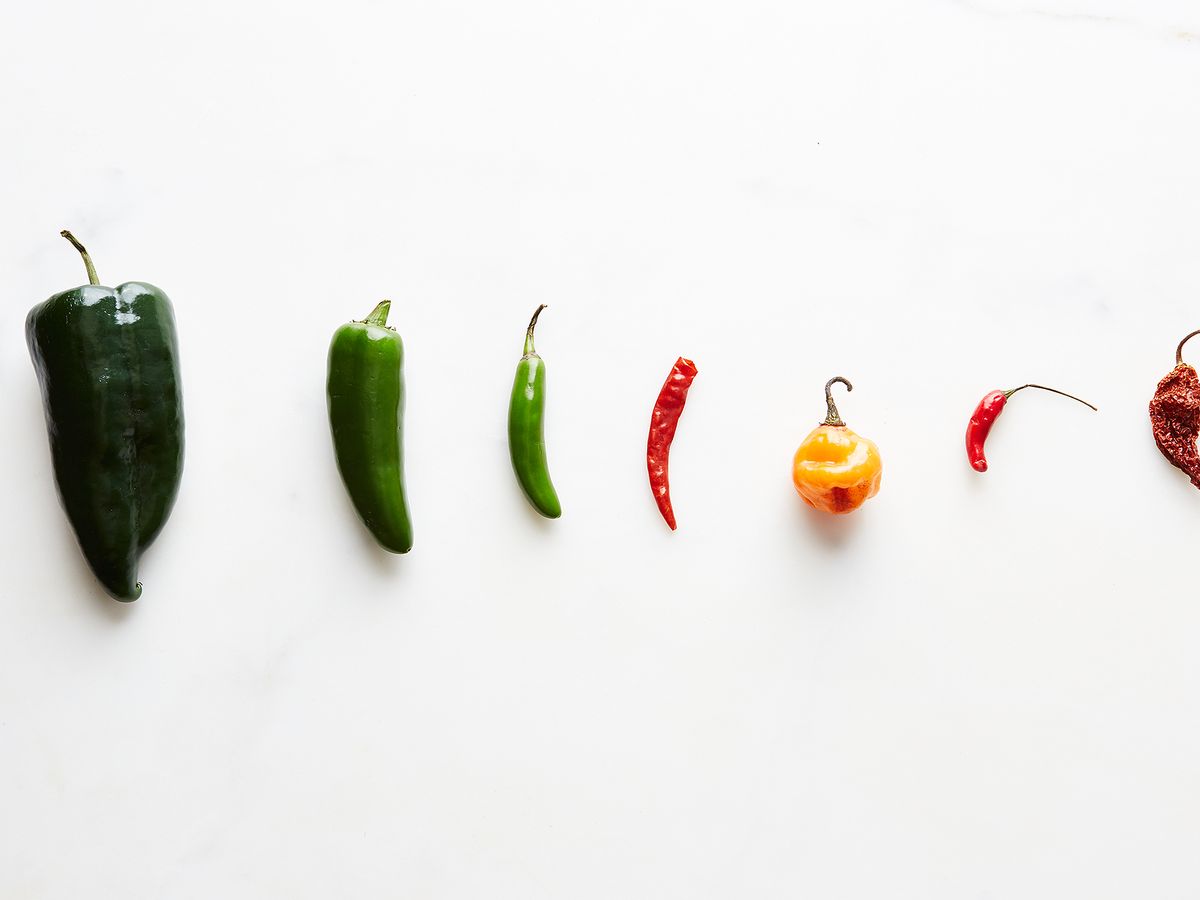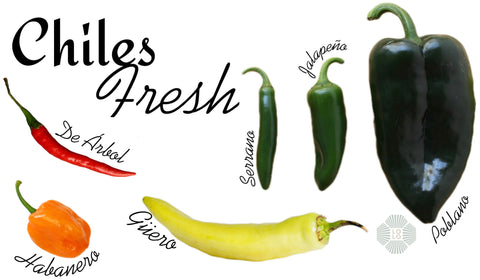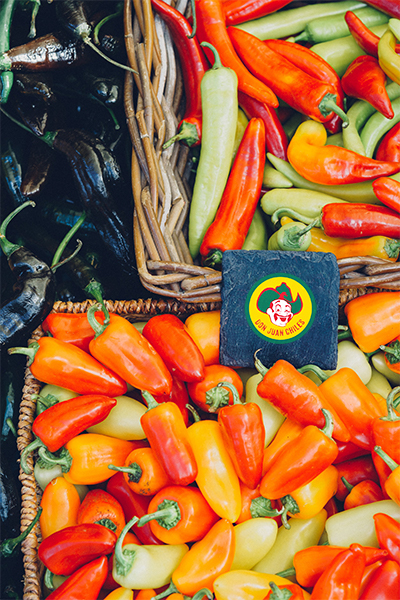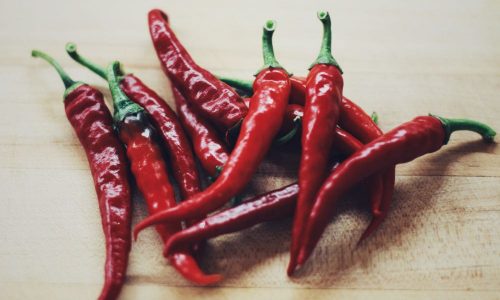The Difference Between Chiles And Peppers

Chiles and peppers are often used interchangeably in culinary discussions, but there are subtle differences between the two. The main distinction lies in their heat levels and flavor profiles. Chiles, belonging to the genus Capsicum, are known for their intense spiciness and wide range of flavors, from smoky to fruity. Peppers, on the other hand, are milder and come in a variety of colors and shapes. While both chiles and peppers add a depth of flavor to dishes, chiles are preferred for those seeking a fiery kick, while peppers are chosen for their versatility and ability to enhance the taste of different cuisines.
Chiles Vs. Peppers: Definition And Origin
Chiles and peppers are often used interchangeably in culinary discussions, but they have distinct definitions and origins. Chiles, also known as chili peppers or hot peppers, belong to the genus Capsicum and have a rich history in Central and South America. Different varieties of chiles, such as jalapeños and habaneros, offer unique flavors and varying levels of heat. On the other hand, peppers, also known as sweet peppers or bell peppers, come in a rainbow of colors and belong to the genus Piper. They are milder in taste and are commonly used in savory dishes for their vibrant colors and crisp texture.
Heat Levels And Scoville Scale Comparison
Heat levels in chiles and peppers are often a topic of fiery debate. The Scoville Scale, developed by Wilbur Scoville in 1912, measures the heat and pungency of chili peppers. Each pepper is assigned a Scoville Heat Unit (SHU) based on its capsaicin content. The higher the SHU, the hotter the pepper. For example, a mild bell pepper measures at 0 SHU, while a fiery habanero pepper reaches up to 350,000 SHU. However, it’s important to note that the heat levels can vary even within the same variety. So, when it comes to choosing chiles or peppers for your recipe, make sure to take the Scoville Scale into consideration.
Common Varieties Of Chiles And Peppers

When it comes to chiles and peppers, there are a wide variety of options to choose from. Some popular varieties of chiles include the Ancho, Jalapeño, and Habanero. Ancho chiles are dried poblano peppers that have a rich, smoky flavor. Jalapeños are medium-sized chiles with a medium level of heat, perfect for adding a spicy kick to dishes. Habaneros, on the other hand, are known for their intense heat and fruity flavor.
As for peppers, common varieties include the Bell, Poblano, and Banana peppers. Bell peppers are mild and come in various colors such as green, red, and yellow. They are great for adding a sweet and crisp element to salads or stir-fries. Poblano peppers, also known as pasilla peppers when dried, have a mild to medium heat level and are often used in Mexican cuisine. Banana peppers, as the name suggests, are long and yellow with a mild heat and are often pickled or used in sandwiches and salads.
Each variety of chile and pepper brings its own unique flavor profile and heat level to dishes, allowing for endless possibilities in culinary creations.
Ancho, Jalapeño, And Habanero: Popular Chiles
Ancho, Jalapeño, and Habanero are three popular varieties of chiles that add distinctive flavors and varying degrees of heat to dishes.
Ancho chiles are dried poblanos that have a deep, smoky flavor with a mild to medium heat level. They are often used in Mexican cuisine, particularly in sauces and stews.
Jalapeños are medium-sized chiles with a bright and slightly tangy flavor. They have a medium level of heat that can range from mild to moderately spicy. Jalapeños are commonly used in salsas, pickles, and as a topping for nachos and burgers.
Habanero chiles are renowned for their intense heat and fruity flavor. They are small and come in a range of colors, from green to orange to red. Habaneros are often used to add a fiery kick to sauces, marinades, and spicy dishes.
These popular chiles offer a range of flavors and heat levels, allowing chefs and home cooks to create diverse and exciting dishes. Whether you prefer mild and smoky or fiery and fruity, Ancho, Jalapeño, and Habanero chiles are sure to elevate your culinary creations.
Bell, Poblano, And Banana: Common Peppers
Bell, Poblano, and Banana peppers are three common varieties that are widely used in cooking. Bell peppers are large, crisp, and come in various colors such as red, green, and yellow. They have a sweet and mild flavor, making them versatile for both raw and cooked dishes. Poblano peppers are dark green, medium-sized, and have a mild to medium heat level. They are often roasted and used in Mexican cuisine, especially in dishes like chiles rellenos. Banana peppers, as the name suggests, resemble bananas in shape and color. They have a mild to medium heat and are commonly pickled or used to add a tangy kick to salads and sandwiches.
Culinary Uses Of Chiles And Peppers

Chiles and peppers are incredibly versatile ingredients that add flavor and heat to a wide range of dishes. Their culinary uses vary depending on their heat level and flavor profiles. Chiles, such as jalapeños and habaneros, are commonly used in salsas, marinades, and spicy sauces. They can also be stuffed, pickled, or used to provide a kick to soups and stews. On the other hand, peppers like bell peppers and poblanos are often used in stir-fries, salads, and roasted dishes. They can be sautéed, grilled, or stuffed with various fillings. Both chiles and peppers can elevate the flavor of meat, seafood, vegetables, and even desserts when used in moderation and with care. So whether you want to add some heat or a subtle sweetness to your culinary creations, chiles and peppers are key ingredients to have in your kitchen.
Flavor Profiles And Cooking Methods
When it comes to flavor profiles, chiles and peppers offer unique tastes that can elevate any dish. Chiles, with their fiery heat, add a bold and spicy kick to recipes. They range from mild jalapeños to the scorching habaneros, each contributing its own distinct flavor. Peppers, on the other hand, provide a milder, sweeter taste that complements a variety of dishes. Whether it’s the crispness of a bell pepper or the rich smokiness of a poblano, peppers bring a delightful balance to any recipe.
In terms of cooking methods, chiles and peppers can be enjoyed in different ways. Chiles are often used in salsas, sauces, and marinades, where their heat can be fully appreciated. They can also be stuffed or pickled, adding a zesty twist to dishes. Peppers, on the other hand, are versatile and can be raw, sautéed, grilled, or roasted. They are commonly used in stir-fries, salads, and even stuffed with various fillings. These cooking methods allow the flavors of chiles and peppers to shine and create culinary masterpieces. So whether you’re seeking a fiery sensation or a subtle sweetness, chiles and peppers have the power to transform your meals.
Pairing Chiles And Peppers With Different Dishes
When it comes to pairing chiles and peppers with different dishes, the possibilities are endless. Chiles, with their fiery heat, add a bold kick to Mexican and Latin American dishes. Think of using jalapeños in salsas, habaneros in spicy marinades, or serranos in tacos. On the other hand, peppers with their milder, sweeter taste can be used in a variety of cuisines. Bell peppers are perfect for stir-fries and salads, poblano peppers add a rich smokiness to enchiladas, and banana peppers are great for sandwiches and pizzas. Experiment with different chiles and peppers to enhance the flavors of your favorite dishes.
Health Benefits And Nutritional Value

Chiles and peppers pack a powerful nutritional punch. They are rich in vitamins, minerals, and antioxidants, making them a valuable addition to any diet. These fiery ingredients are known to boost metabolism, aid in digestion, and support overall gut health. They are also a good source of capsaicin, a compound that has been linked to numerous health benefits, including pain relief and improved cardiovascular health. Additionally, chiles and peppers provide a burst of flavor without adding extra calories or fat. So, whether you enjoy the heat of chiles or the mildness of peppers, incorporating them into your meals can offer a range of health benefits.
Vitamins, Antioxidants, And Capsaicin Content
Chiles and peppers are not only flavorful, but they are also packed with essential vitamins and antioxidants. These fiery ingredients are a rich source of vitamins A and C, which are important for maintaining healthy skin, boosting the immune system, and promoting overall well-being. Additionally, chiles and peppers contain high levels of antioxidants that help protect against cellular damage and reduce inflammation. One of the key components found in chiles is capsaicin, which gives them their spicy kick. Capsaicin has been shown to have numerous health benefits, including pain relief, improved circulation, and even weight management. So, whether you prefer the milder taste of peppers or the fiery intensity of chiles, you can enjoy their nutritional properties and the added kick of capsaicin.
Digestive Health And Metabolism Support
Chiles and peppers not only add flavor and heat to dishes, but they also offer benefits for digestive health and metabolism support. Capsaicin, the compound responsible for the spicy kick in chiles, has been shown to stimulate the production of digestive enzymes, promoting better digestion. Additionally, capsaicin has been linked to an increase in metabolism, helping to burn calories and potentially aid in weight management. The combination of vitamins and antioxidants found in chiles and peppers further contributes to overall gut health and optimal digestion. So, incorporating these fiery ingredients into your meals can provide a tasty boost to both your digestive system and metabolism.
Growing And Harvesting Chiles And Peppers

Growing chiles and peppers requires specific climate and soil conditions. These plants thrive in warm temperatures and prefer well-drained soil with plenty of organic matter. They need a longer growing season to reach their full potential.
Once the plants have matured and produced fruit, it’s time for harvest. Chiles are typically harvested when they reach their desired level of ripeness, which can vary depending on the specific variety. Peppers, on the other hand, can be harvested when they are still green or left to ripen to their desired color.
When harvesting chiles and peppers, it’s important to handle them with care to avoid bruising or damaging the fruit. Using sharp scissors or pruners, cut the fruit from the plant, leaving a short stem attached. This helps to preserve the freshness and allows for easier handling during culinary preparations.
To ensure a continuous harvest, it’s recommended to pick the fruit regularly as it ripens. This encourages the plant to continue producing more chiles and peppers throughout the growing season.
To preserve the harvest, chiles and peppers can be dried, frozen, or pickled. Drying them can help intensify the flavors and make them last longer. Freezing is a convenient option for maintaining the texture and taste. Pickling allows for a tangy and vibrant preservation method.
By understanding the appropriate growing conditions and proper harvesting techniques, home gardeners and farmers alike can enjoy a bountiful supply of flavorful chiles and peppers throughout the year.
Climate And Soil Requirements
To successfully grow chiles and peppers, it is crucial to understand their climate and soil requirements. These plants thrive in warm temperatures, preferably between 70-90°F (21-32°C). They require a longer growing season, typically 60-90 days, to reach their full potential.
When it comes to soil, chiles and peppers prefer well-drained soil with plenty of organic matter. Sandy loam or loamy soil is ideal, as it provides good drainage while retaining enough moisture. The pH level of the soil should be slightly acidic to neutral, ranging from 6.0-7.0.
It is important to note that chiles and peppers are susceptible to cold temperatures, frost, and excessive rainfall, which can stunt their growth and affect fruit production. Therefore, it is advisable to plant them after the danger of frost has passed and provide protection during adverse weather conditions.
By providing the right climate and soil conditions, chiles and peppers will thrive and reward you with a bountiful harvest of flavorful and fiery fruits.
Harvesting Techniques And Preservation Methods
When it comes to harvesting chiles and peppers, it is important to wait until the fruits are fully mature and have developed their vibrant colors. Most chiles and peppers can be harvested when they are green, but they will continue to ripen and change color as they mature. To harvest, simply cut the stems near the base of the plant using a sharp pair of shears or scissors.
To preserve the harvest, there are several methods you can choose from. One popular method is drying the chiles and peppers. This can be done by hanging them in a well-ventilated area, or by using a dehydrator or oven set on low heat. Once fully dried, the chiles and peppers can be stored in airtight containers for future use.
Another preservation method is pickling. This involves immersing the chiles or peppers in a vinegar-based brine, along with other spices and flavorings. The pickled chiles and peppers can be used to add a tangy kick to various dishes.
Canning is another option for preserving chiles and peppers. This involves sterilizing jars, packing them with the chiles or peppers, and covering them with a pickling or preserving liquid. The jars are then processed in a hot water bath or pressure canner to ensure long-term preservation.
Freezing is also a simple preservation method. Wash and dry the chiles and peppers, then slice or chop them before placing them in freezer bags or containers. They can be stored in the freezer for several months and used as needed.
By using these harvesting techniques and preservation methods, you can enjoy the fiery flavors of chiles and peppers all year round.
Conclusion

In conclusion, the debate between chiles and peppers is not easily settled. Both have their unique flavors, heat levels, and culinary uses that cater to different preferences and dishes. Chiles are known for their fiery heat and vibrant flavors, while peppers offer a milder taste and a variety of colors. They both bring a burst of flavor to dishes and can be used in various cuisines around the world. Whether you’re a fan of the spicier chiles or prefer the milder peppers, both have their place in the culinary world, satisfying the taste buds of people worldwide.
Recap Of Key Differences And Similarities
Peppers and chiles may share similarities, but they also have distinct differences. Peppers are known for their sweetness and mild flavor, while chiles bring the heat and spice to the table. Peppers are often used fresh, while chiles are commonly dried and used in powdered or flaked form. Both are rich in vitamins, antioxidants, and capsaicin, which offer various health benefits. When it comes to culinary uses, peppers are versatile and can be enjoyed in various dishes, while chiles add a fiery kick to Mexican and Asian cuisines. So, whether you prefer the mild sweetness of peppers or the fiery heat of chiles, both have their unique flavors and contributions to the culinary world.
Final Thoughts On Chiles Vs. Peppers Debate
In the fiery debate between chiles and peppers, it’s clear that they have both differences and similarities. While some may use the terms interchangeably, it’s important to recognize their distinct qualities. Chiles bring the heat and spice, adding a fiery kick to dishes, particularly in Mexican and Asian cuisines. On the other hand, peppers are known for their mild sweetness and versatility, adding flavor to a wide range of dishes. Both chiles and peppers offer various health benefits, thanks to their rich vitamin and antioxidant content. Whether you prefer the heat of chiles or the sweetness of peppers, they both have a place in the culinary world.
FAQ About Chiles Vs Peppers: The Fiery Debate Unraveled
Q: What is the main difference between chiles and peppers?
A: The terms “chiles” and “peppers” are often used interchangeably, but technically, chiles refer to spicy peppers, whereas peppers can include both sweet and hot varieties.
Q: Are chiles and peppers the same when it comes to heat?
A: Not necessarily. Chiles are typically spicier than peppers due to their higher capsaicin content, which is the compound responsible for the heat in peppers.
Q: How can one differentiate between chiles and peppers?
A: Chiles are known for their fiery flavor and are commonly used in spicy dishes, whereas peppers encompass a broader range that includes bell peppers, sweet peppers, and mildly spicy varieties.
Q: Which is more versatile in cooking, chiles, or peppers?
A: Both chiles and peppers have their unique culinary uses. Chiles are often used to add heat and flavor to dishes, while peppers are favored for their sweetness and colorful addition to various recipes.
Q: Can chiles and peppers be substituted for one another in recipes?
A: It depends on the recipe and individual taste preferences. Substituting chiles for peppers or vice versa may alter the flavor profile of the dish, so it’s best to consider the intended heat level and flavor impact before making a substitution.
Q: Are there health benefits associated with consuming chiles and peppers?
A: Both chiles and peppers contain beneficial nutrients and antioxidants. Chiles, in particular, are known for their potential health benefits, such as boosting metabolism and reducing inflammation, due to their capsaicin content.

Duke City Kitchen, known for its fresh, simple, and delicious cuisine, has a rich history deeply rooted in the heart of the local food scene. Since its inception, Duke City Kitchen has been dedicated to providing an exceptional dining experience that celebrates the region’s flavors. Founded by a passionate group of food enthusiasts, Duke City Kitchen opened its doors with the vision of offering a welcoming space where people could gather to enjoy thoughtfully prepared meals made from the finest, locally sourced ingredients. This commitment to quality and community has been a driving force behind Duke City Kitchen’s success.